On the Road is a weekday feature spotlighting reader photo submissions.
From the exotic to the familiar, whether you’re traveling or in your own backyard, we would love to see the world through your eyes.
On the Road: Week of December 28 (5 am)
Albatrossity – Winter Hawks of 2020
Kody Kastel – California Photos
?BillinGlendaleCA – The Great Conjunction
Captain C – Goes To Japan: Second Tokyo 2
Steve from Mendocino – Provence, FranceOn the Road: After Dark: Week of December 28 (10 pm)
Origuy – Road Trip 2006 Part Two
Mike in Oly – Mt. St. Helens National Volcanic Monument
KarenH – Great Sand Dunes National Park
Ghosts of Holidays Past – Christmas Snippets
Ghosts of Holidays Past – Christmas at Rockefeller Center
? And now, back to Albatrossity, for Winter Hawks of 2020.
Albatrossity
Time for another installment of the Winter Hawks of Kansas, methinks. As you know if you have driven through the state in winter, we are blessed with a tremendous number and variety of raptors at this time of year.
Some are residents, many are migrants from the north. Some return to the same territory year after year, while others, particularly the youngsters who hatched out last summer, have to work hard to find an unoccupied territory and survive the winter. And every year, some don’t return, having succumbed to one of the myriad hazards of migration between here and, in some cases, Alaska or the Canadian Arctic.
So here’s a sampler from the season so far, with some familiar faces and lots of new ones.
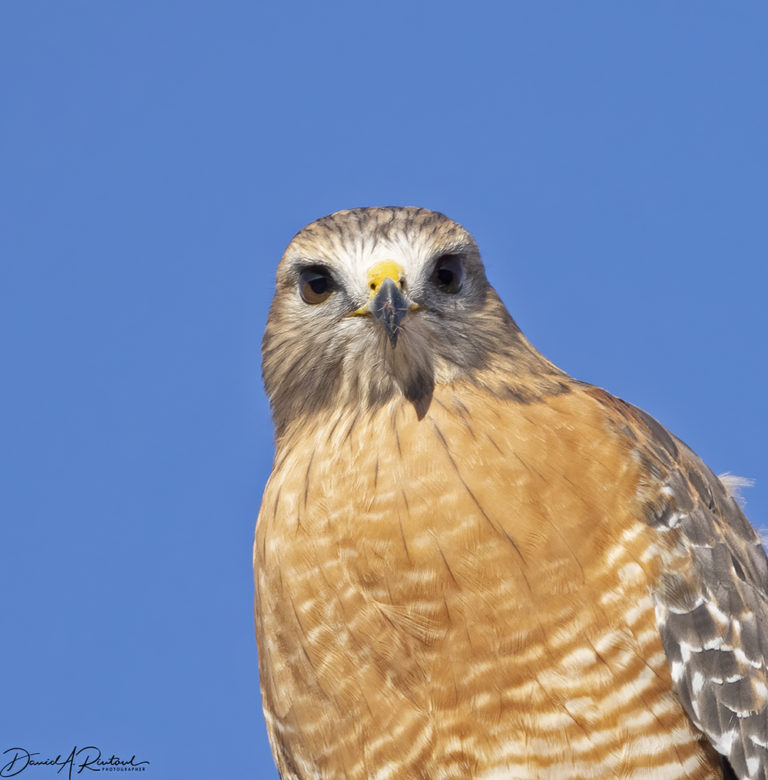
Red-shouldered Hawks (Buteo lineatus) are one of the resident species, and are becoming quite common in my area, This one was photographed on our annual Christmas Bird Count, and was one of three I saw that day. But 30 years ago it would have been a hotline bird, and a report of this bird on the CBC would have earned me a grilling from the compiler about the details of the sighting, how I eliminated other species, etc. Today it is not exactly a ho-hum bird here, but the fact that I found three in my area tells you that they are doing quite well here.
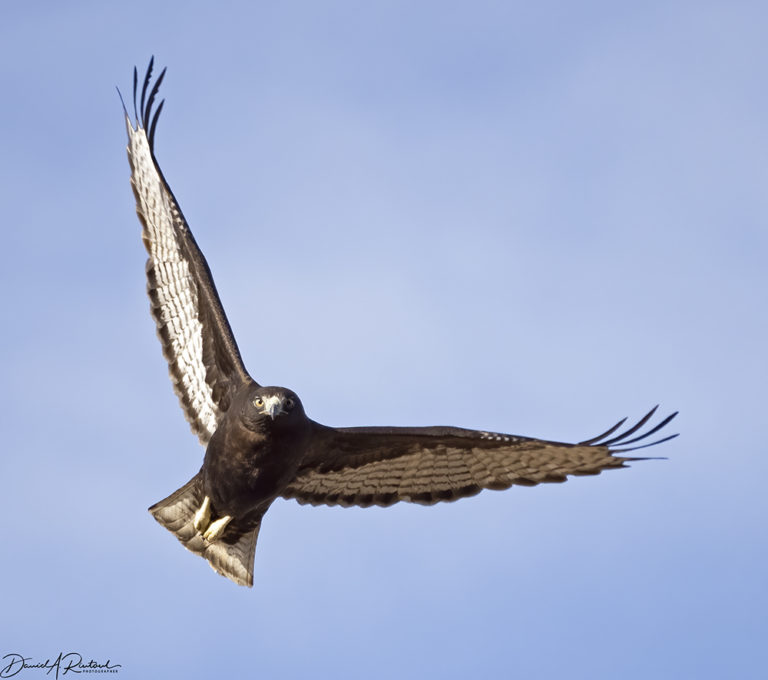
One of the most spectacular winter migrant hawks here is the dark-morph version of the Red-tailed Hawk subspecies known as Harlan’s Hawk (Buteo jamaicensis harlani). This one might be a returnee from the Yukon or Alaska; it is a second-year bird and was in an area where I sighted a first-year bird several times last winter. Audubon dubbed this the Black Warrior, and it is easy to see why that name is apt.
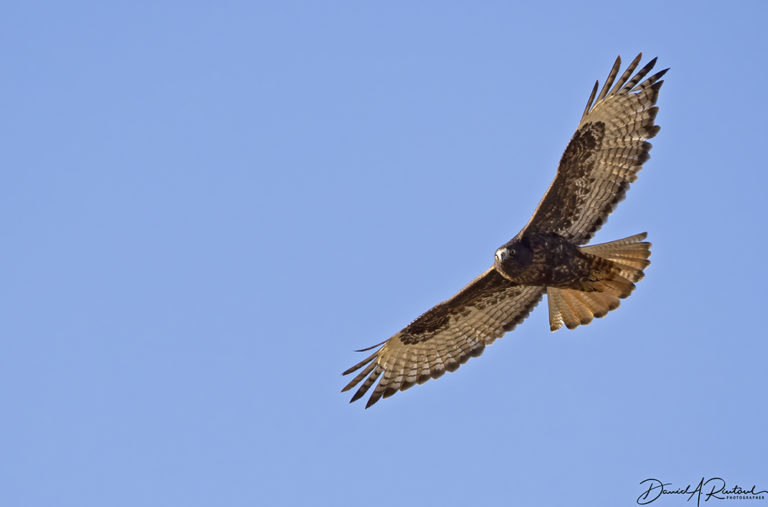
Another dark-morph, but a different subspecies. This western Red-tailed Hawk (Buteo jamaicensi calurus) is also a second year bird, and is trying to fit into a spot on the edge of an established Harlan’s Hawk territory. So far this season they are co-existing, though not always amicably!
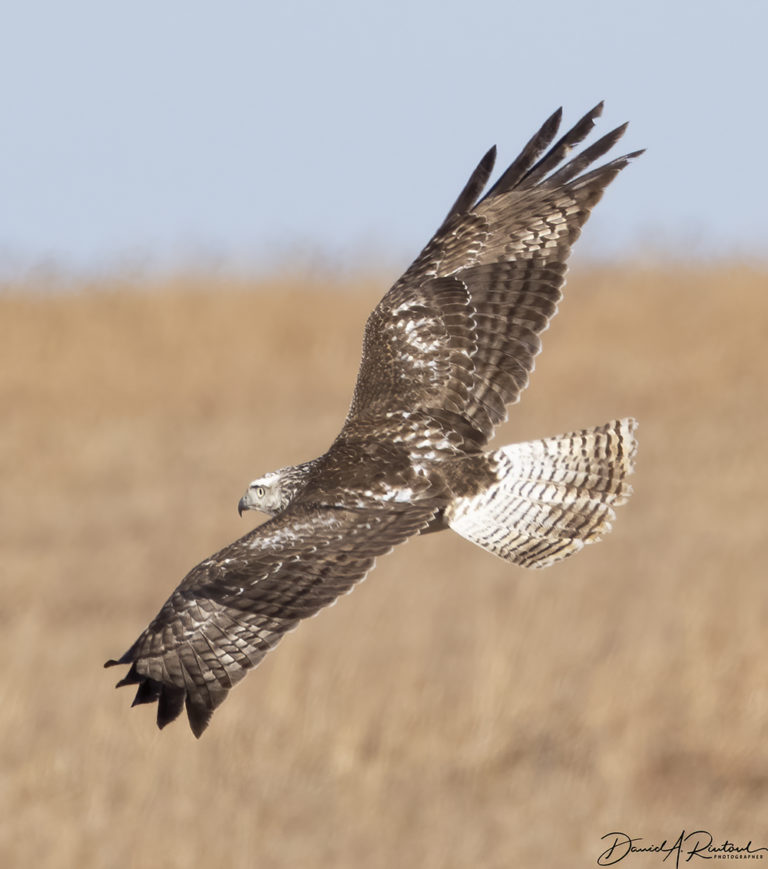
On the opposite end of the spectrum, pigment-wise, is the subspecies known as Krider’s Hawk (Buteo jamaicensis kriderii) . This is also a migrant from points north, although not as far north as the Harlan’s. This one was identified as a juvenile Krider’s Hawk, perhaps with some genes from the eastern redtail (B. j. borealis) side of the family.
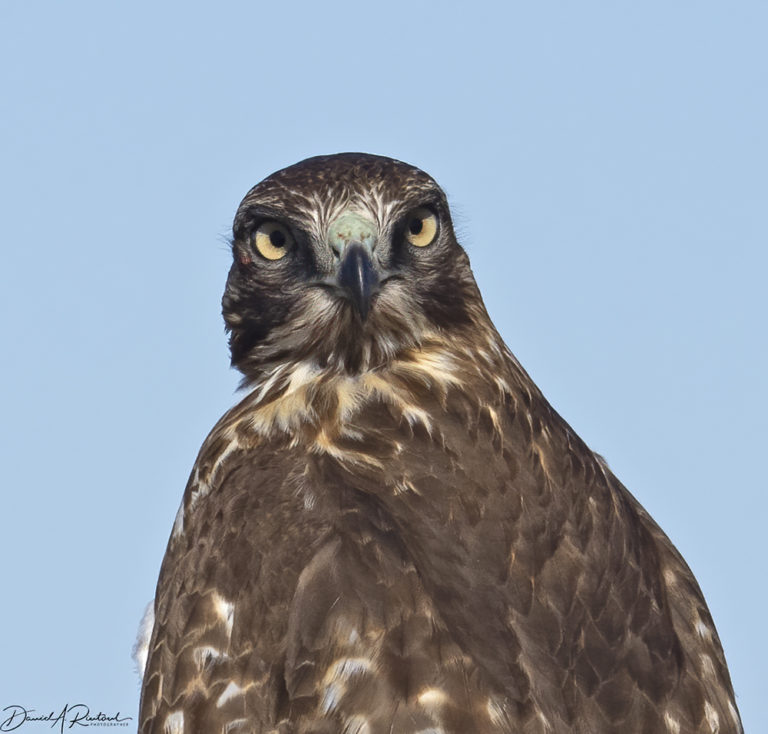
Young hawks are routinely more tolerant of photographers, in my experience. This young Red-tailed Hawk not only tolerated me, it tolerated another photographer at the same time, and mostly stretched, loafed, and pooped while we were photographing it.
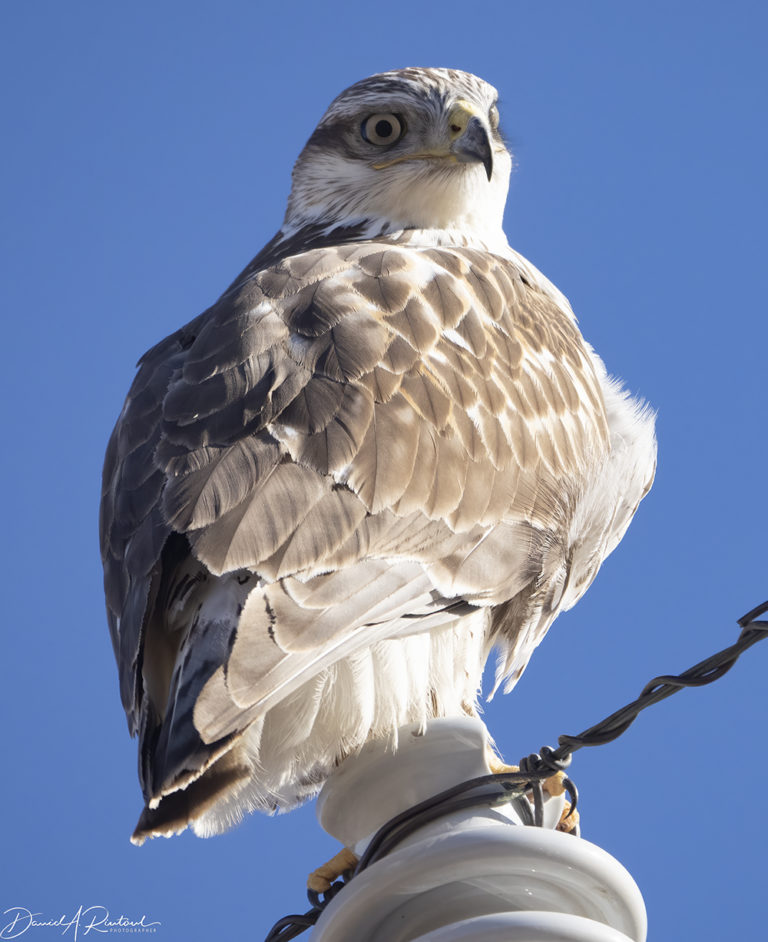
Just like the young redtail above, this first-year Ferruginous Hawk (Buteo regalis) mostly was content to watch me, perhaps sizing me up as a potential meal.
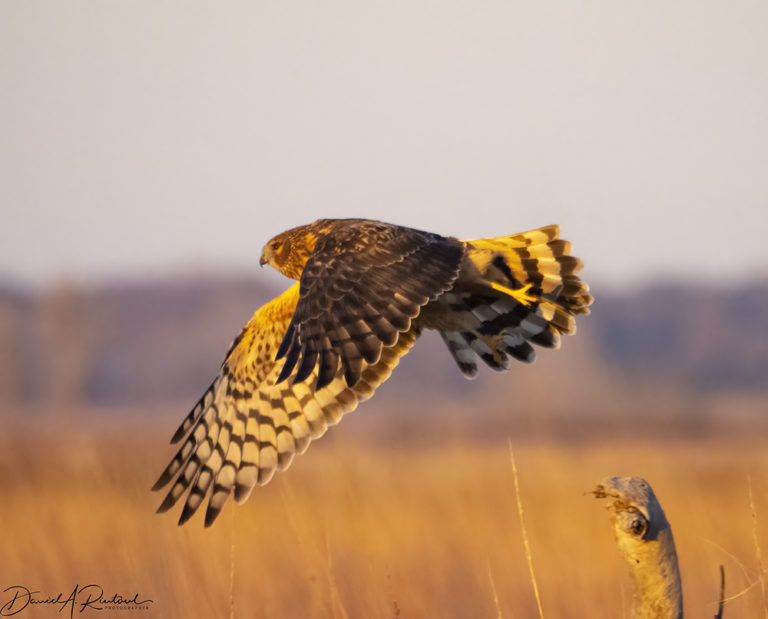
Northern Harriers (Circus hudsonius) do stay for the summer in western KS, but they are winter birds in my part of the state. They are constantly on the move, and thus are a challenge to photograph, but this female Northern Harrier in dawn light was worth a shot.
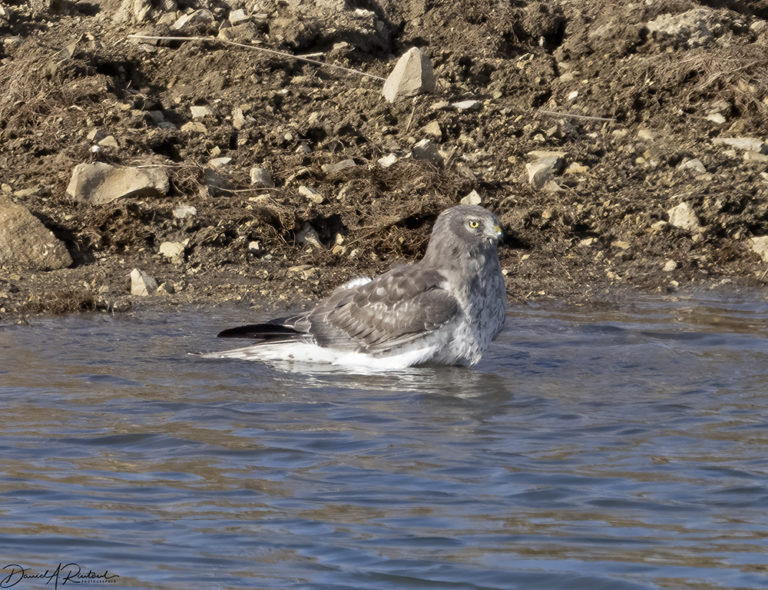
This is a sight I have not seen before. As noted above, Northern Harriers are constantly on the move. It is rare to see them on the ground, and even more rare to catch them in an unguarded moment like this. This male was very cautious, first perching on the shore of this pond, then, after a few minutes, he moved out into the water. After a few more minutes, he moved to slightly deeper water and proceeded to dunk and splash and bathe vigorously for a bit. I felt a bit like a voyeur, but it was a unique opportunity and I wanted to document it!
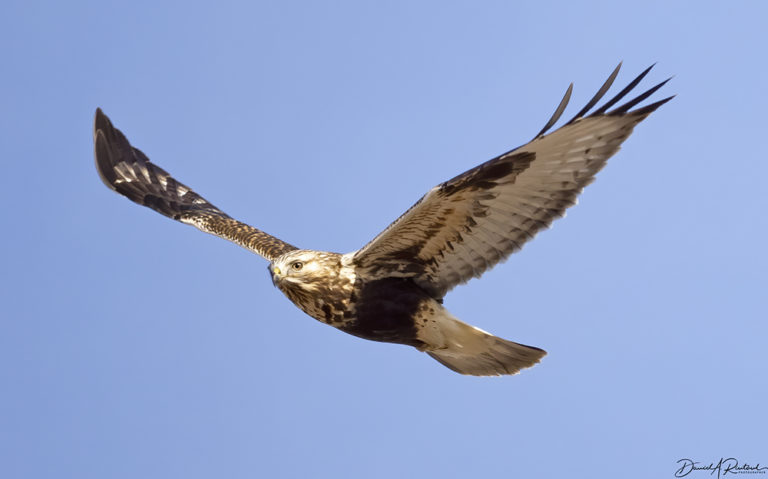
Another migrant from the far North, a first-year Rough-legged Hawk (Buteo lagopus). In some winters they are scarce here, perhaps because there is ample food up north in Nebraska or Iowa. Last year, for example. I found exactly three all winter long. This winter is different, I have already seen 8-10 of these striking birds, and it’s not yet 2021!
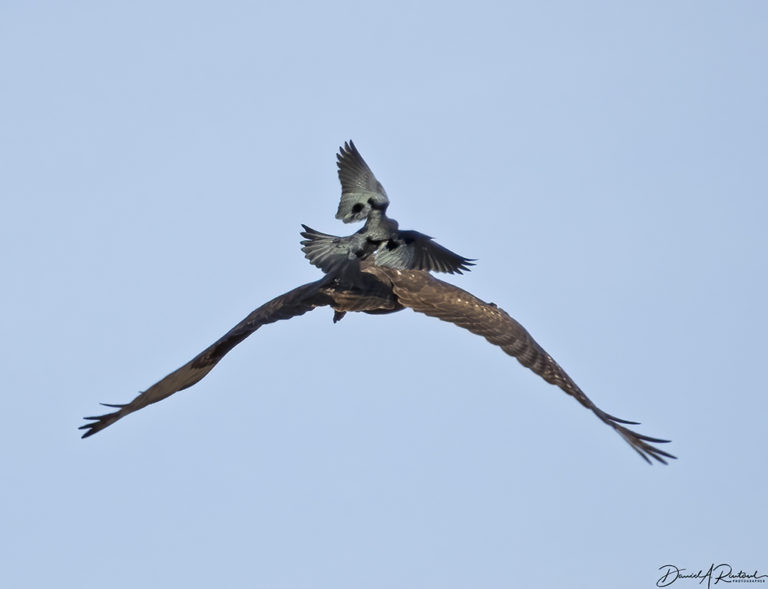
Finally, here’s a shot that shows how it ain’t easy being a hawk. This Harlan’s Hawk was being hassled by a Common Grackle (Quiscalus quiscula), who lit out after the hawk as soon as the hawk took off. He smacked the hawk at least a couple of times, and there really wasn’t much that the hawk could do about that.

Wag
Spectacular, as always. Thanks. I love raptors.
SiubhanDuinne
Beautiful coloration on the breast feathers of the young Ferruginous hawk. Looks like meringue :-)
Geo Wilcox
We have had a breeding pair of red shouldered hawks on our farm since we’ve owned it. We put in a small pond n the front yard, fed by a spring that never stops. Every year the older hawks bring their young to train them to hunt fish and frogs. The pond is about 30 feet from the front of the house so we get to watch the training a lot.
It has been amusing to watch that’s for sure. The older hawks first show the kids how it is done. Swooping down on some poor fish (we stocked it for them) and flying off clean. Inevitably one of the kids will eat it head first into the water, leaving the rest avianly laughing at it or the parents flying off in seeming disgust.
We also have green herons who use the pond to teach their offspring how to hunt but never at the same time as the hawks for obvious reasons.
swiftfox
Hypothesis/question: The increase in red-shouldered hawks may be because of an increase in forested riparian areas in KS? I’ve heard that the conservation reserve program has been abused so this would be a pleasant surprise.
raven
So the last shot is like the “mobing” we saw when a bard owl was in out back yard and the bluejays attacked it all day?
raven
They beat the owl up so badly that it wore all the feathers off of the back of its head.
I’m not the greatest photographer but check out the claws on this dude.
JPL
@Geo Wilcox: What a fascinating story. Hawks are abundant in GA, and I’ve seen several species in my yard, but no nests.
JPL
@raven: I wonder if the Blue Jay was protecting a nest, or just being ornery.
raven
@JPL: Our neighborhood wildlife biologist (works for DNR and went to Yale) said, yes, they are protecting their nests. He said owls are killing machines (not unlike cats).
Rob
The last shot with the grackle is really good
Elizabelle
Love all the bird photos.
Including raven’s. The Cadfael owl, now with a tonsure. That owl was stubborn, to remain in the tree.
Tdjr
That first picture took my breath away! Awesome!
I was watching a hawk perched on top of a telephone pole in my neighborhood when I heard a commotion in the trees nearby. A few crows were harassing another raptor but I couldn’t see what it was. Apparently it got ticked off enough to swoop out after them. It was a beautiful peregrine falcon. He didn’t get any of the crows but it was thrilling to see him try.
Albatrossity
@swiftfox: Yes, that is my hypothesis as well. As human habitation in the eastern part of the state increases (while decreasing in the western half of the state), there are more trees on what was formerly prairie. More trees = more Red-shouldered Hawks
Elizabelle
@Albatrossity:
Good hypothesis. How much do you think the birdlife you are seeing is due to climate change migration and habitation patterns?
What birds do you miss, that have decamped for parts elsewhere??
raven
@Elizabelle: It was weird, it lasted all day and it moved down to the fence post in the afternoon and then went back into the tree.
MazeDancer
What gorgeous pictures!
Albatrossity
@Elizabelle: Not sure that migration patterns have changed much for hawks, but, like most of the USA, we have a lot more Canada Geese in the summer now (they used to migrate north) and lots more Snow Geese in the winter (they used to spend the winter further south of us).
Climate change has affected lots of birds. Mississippi Kites and Scissor-tailed Flycatchers have moved significantly further north than when I was a kid; both are regular breeding birds here now.
The big one, IMHO, is human alteration of the habitat. Flying insect populations have dropped (for lots of reasons), and with that, populations of insectivores like Common Nighthawks are crashing. Loggerhead Shrikes used to be common here year-round, now I see one or two in the summer, but I have not seen one in winter in 30 years now. Climate change is also affecting other insects in interesting ways. Here’s a commentary on a PNAS publication about nutrient dilution that I may have mentioned here before; my daughter Ellen is the first author on the PNAS paper. And if insects are affected, nearly all birds will feel those effects.
Elizabelle
@Albatrossity: The flying/other insect population. Had not thought about that. Right.
Had guessed you might be seeing a lot of birds who might have flown further south wintering in Kansas …
Albatrossity
@Elizabelle: Yes, besides the geese, we now have wintering Sandhill Cranes, and more frequent sightings of birds that historically would be further south (Orange-crowned Warbler, Eastern Phoebe, Dickcissel, etc.). This winter, probably due to displacement from the summer fires in the Rockies, we have had an influx of western birds (Mountain Bluebirds, Scrub Jays, and even one Piñon Jay).
Elizabelle
@Albatrossity: Ah. Birds displaced by fire as well.
2020 was a bad year for our feathered friends, too.
UncleEbeneezer
Lovely pix. We have a couple Red Tails (I think) that live in the area that I often see around the San Gabriel foothills. Yesterday one was perched in the tree just outside our tiny yard until the crows (who constantly fight with the Pasadena Parrots) chased it off. Thankfully, because as cool as it was to have the hawk there, we have a couple feral cats that we take care of that might have been a target for this BIG hawk.
J R in WV
As usual, wonderful photos and educational commentary from our resident expert on birbs.
Many years ago I left our house for work about 8 am, and was stopped dead in my tracks to the scene on the roof of the house across the street. We were in a very old development in town, on a steep hillside with large spruce and hemlock trees around the homes.
There was a great horned owl on the chimney, being mobbed by a small flock of crows. They are huge night raptors, and it was surrounded by black crows taking passes at the Owl. Owl would periodically lunge off the perch and grab a crow, usually a fatal blow.
After a few more minutes, Great Horned Owl suddenly sprang up from the chimney and flew into a really big hemlock tree, with thick evergreen foliage, which kept the crows from being able to continue their attack on the big owl. I left for work, still amazed. Others in our house were night workers, sound asleep for all the action. I so wish I had had a camera with, but in the 1970s cameras were not the ubiquitous tools built into cell phones they are today. All I have are the memories…
We have several Barred Owls here, they roost on the ridge top just north of our current house site, and will hoot back and forth. I can talk with them, although I don’t know what they are saying, nor what they think I’m saying. We hoot together some evenings as they prep for a night’s work hunting in the woods.
pat
Speaking of declining insect population, I have been photographing bugs (butterflies, bees, wasps, anything that flies and will sit on a flower in front of me) for a few years and I have never seen so FEW flying insects as this year. Scary.
eta; In western Wisconsin near the Mississippi river.
Albatrossity
@UncleEbeneezer: Yeah, probably Red-tailed Hawks in your part of the world.
But don’t worry about them taking your cats. Most hawks can haul off about half their weight (with difficulty), and since the hawks weigh about 2-3 lbs, they couldn’t carry off more than a tiny kitten. They look big, but they are mostly feathers, and cats are not on their typical menu.
J R in WV
@Albatrossity:
Friends in Pueblo, CO kept their cats indoors, but for a second floor balcony they could go out on to lay in the sun.
One day one of their indoor cats disappeared from that balcony, leaving a couple of feathers behind. Was a small cat, they believed cat was taken by a very large owl in the neighborhood.
Either Great Horned Owl or Barred Owl, both of which were in the area. No telling, no one saw the event.
Albatrossity
@J R in WV: Yes, I have seen a Great Horned Owl haul off a small cat; they are bigger than a typical Red-tailed Hawk. But I have also watched a Red-tailed Hawk struggle to lift a squirrel. And Barred Owls weigh even less. In that part of CO, it is at least theoretically possible it was a Golden Eagle, which can (and do) catch and eat larger prey.
Predators, if they are hungry and desperate, might attack anything. So it can happen that a small cat is taken by an avian predator. That being said, it is VERY unlikely that any decent-sized cat is in much danger from a Red-tailed Hawk. There are certainly lots of anecdotes about that, but when it comes to the details, nobody can say that they saw the attack. They just say that there was a hawk in the neighborhood, and that the cat (or dog) disappeared…
J R in WV
@J R in WV:
Also, our SW West Virginia barred owls would, back when we kept livestock, ocasionally help themselves to yard bird chickens roosted in a big cedar tree just outside the kitchen door.
Sometimes just gone, sometimes a trail of feathers down the tree, across the bottom, with a bloody feathered spot where dinner happened in the wee hours of the night.
The risk the yard bird chickens sometimes paid to not return to the chicken coop every evening… freedom has its price!